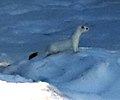Top Qs
Timeline
Chat
Perspective
American ermine
Species of mammal (mustelid) From Wikipedia, the free encyclopedia
Remove ads
The American ermine or American stoat (Mustela richardsonii) is a species of mustelid native to most of North America. The specific epithet refers to Arctic explorer and naturalist John Richardson.
Remove ads
Description
The American ermine has a body plan typical of weasels. It has short legs, a long body and neck, and a small triangular head with short round ears. It has a brown dorsum with a white venter (except during winter when the coat is fully white) and a short, black-tipped tail.[2]
Taxonomy
It was long considered conspecific with the stoat (M. erminea), but a 2021 study found it to be a distinct species, forming distinct genetic clades from erminea.[3][4][5] The finding has been accepted by the American Society of Mammalogists.[6] The Haida ermine (M. haidarum) is thought to be a hybrid species originating from ancient hybridization between M. erminea and M. richardsonii.[3]
Remove ads
Distribution
The species is found throughout most of North America aside from most of Alaska (although it is found on some islands in southeastern Alaska), eastern Yukon, most of Arctic Canada, and Greenland, where it is replaced by M. erminea. It reaches the northern extent of its range in Ellesmere Island and a portion of eastern mainland Nunavut and ranges from here to cover almost all of western North America south to northern New Mexico, and eastern North America south to northern Virginia. It is absent from most of the Southeastern United States and the Great Plains.[3]
Diet
In North America, where the ecological niche for rat- and rabbit-sized prey is taken by the larger long-tailed weasel (Neogale frenata), the American ermine preys on mice, voles, shrews, young cottontails,[7] chipmunks, deer mice, jumping mice, and house mice. Usually the ermine kills by biting at base of skull. Small birds, frogs, small fish, and earthworms are other types of prey for ermines.[8]
Remove ads
Habitat
Ermines live and find cover from predators in hollow spaces in logs, burrows and man-made structures. Ermines sometimes den within their prey's nest, and use their prey's skin and fur as a lining for their den.[8]
Breeding
They breed in dense parts of the forest. The season for breeding is late springtime to the summer from July to August. The males mature in a year while the females only take three to four months to mature. The females carry a litter of four to seven babies for 255 days then gives birth.[1]
Predators
Some of the larger wild predators of ermines are minks, martens, fishers, bobcats, coyotes, and large owls and hawks. Occasionally a domesticated cat or dog may kill an ermine. Their small agile bodies help them evade these predators, while also allowing them to compete with their predators for food in more barren months.[8]
Subspecies
Summarize
Perspective
About 13 subspecies are known:
Remove ads
Relationships with humans
The fur of ermine was valued by the Tlingit and other indigenous peoples of the Pacific Northwest Coast. They could be attached to traditional regalia and cedar bark hats as status symbols or made into shirts.[11]
Gallery
- Skulls of a long-tailed weasel (top), an American ermine (bottom left), and least weasel (bottom right), as illustrated in Merriam's Synopsis of the Weasels of North America
- Winter coat
References
Bibliography
Wikiwand - on
Seamless Wikipedia browsing. On steroids.
Remove ads






